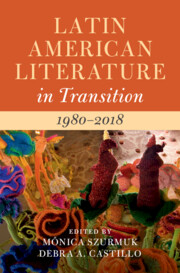Book contents
- Latin American Literature in Transition 1980–2018
- Latin American Literature in Transition
- Latin American Literature in Transition 1980–2018
- Copyright page
- Contents
- Contributors
- Acknowledgments
- Introduction
- Part I Security
- Chapter 1 Geological Writings
- Chapter 2 Literature, Trauma, and Human Rights
- Chapter 3 Literatura de Hijos in Post-Dictatorship South America
- Chapter 4 Mexican Narconarratives after Narcos
- Part II New Genres
- Part III Mobilities
- Part IV Positionalities
- Part V Latin American Literature in Global Markets
- Index
- References
Chapter 4 - Mexican Narconarratives after Narcos
from Part I - Security
Published online by Cambridge University Press: 24 November 2022
- Latin American Literature in Transition 1980–2018
- Latin American Literature in Transition
- Latin American Literature in Transition 1980–2018
- Copyright page
- Contents
- Contributors
- Acknowledgments
- Introduction
- Part I Security
- Chapter 1 Geological Writings
- Chapter 2 Literature, Trauma, and Human Rights
- Chapter 3 Literatura de Hijos in Post-Dictatorship South America
- Chapter 4 Mexican Narconarratives after Narcos
- Part II New Genres
- Part III Mobilities
- Part IV Positionalities
- Part V Latin American Literature in Global Markets
- Index
- References
Summary
After at least two decades of the proliferation of narconarratives mediated by the official discourse of “drug cartels,” an emerging current of writers, filmmakers, and journalists have renewed a critical approach to state violence and its implications beyond typical assumptions about organized crime. From the thousands of killings of the so-called war on drugs to the forced disappearance of forty-three students in the state of Guerrero in 2014, this counterhegemonic critique aims to rethink – and, more importantly, to reimagine – the most pressing events of violence as the result of social strategies of control and exploitation promoted by state structures and geopolitics. This essay proposes to analyze the politicized imagination intersecting state violence and drug trafficking that deliberately leaves behind the habitual hegemonic narconarratives to articulate instead a critical understanding of the criminal networks as by-products of official power. Along with the analysis of key works of fiction, film, and journalistic investigations, I will engage debates on state violence and neoliberalism in the age of permanent national security crises.
- Type
- Chapter
- Information
- Latin American Literature in Transition 1980–2018 , pp. 63 - 76Publisher: Cambridge University PressPrint publication year: 2022



